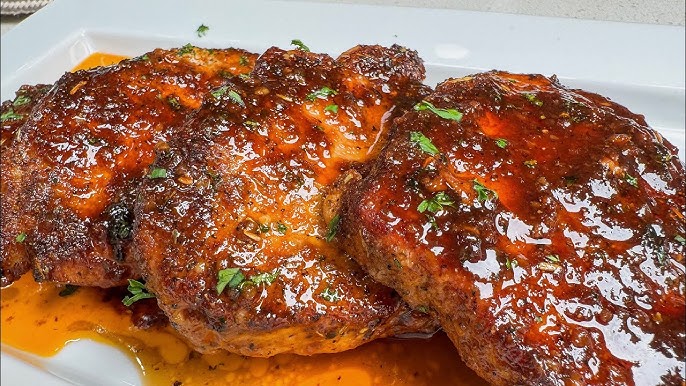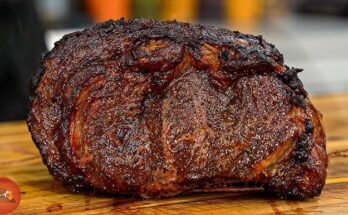Bone in Pork Chops Recipe: Few dishes feel as comforting and satisfying as a juicy, perfectly cooked bone-in pork chop. Whether you’re planning a weekday dinner or an impressive meal for guests, this step-by-step guide will walk you through everything you need to know. From choosing the right cut to the final resting stage, let’s transform your pork chops from basic to brilliant.
Why Choose Bone-in Over Boneless?
When it comes to pork chops, you might wonder if the bone really makes a difference. Spoiler alert: it absolutely does. Bone-in pork chops aren’t just a visual upgrade—they carry significant advantages in both flavor and texture. The bone acts as a barrier, helping retain moisture during cooking and preventing the meat from drying out.
Cooking with the bone in can also contribute to a richer flavor. That bone marrow subtly infuses into the meat while cooking, especially in methods like roasting or pan-searing. Think of the bone as a flavor booster built right into the meat. Plus, bone-in cuts often include more fat marbling, which only adds to the taste and juiciness.
Lastly, bone-in pork chops tend to be thicker than their boneless counterparts. That means they’re more forgiving during cooking, reducing the risk of accidentally turning your pork into rubber.
Flavor and Texture Benefits
The flavor is where bone-in pork chops shine the most. The combination of bone, fat, and meat makes for a naturally juicy cut with a full-bodied taste. Unlike boneless pork chops, which can sometimes turn out bland or chewy, bone-in varieties stay moist and flavorful with minimal effort.
The texture is also superior. The meat around the bone tends to be more tender and succulent, making each bite more enjoyable. If you’ve ever had a dry, overcooked boneless chop, you’ll appreciate the difference a bone makes. And that little bit of extra chew near the bone? That’s where some of the best flavors live.
Essential Ingredients for Juicy Bone-in Pork Chops
Main Ingredients List
For an unforgettable pork chop, you need more than just the meat. The right ingredients ensure your chops are bursting with flavor, juicy on the inside, and crispy on the outside. Here’s what you’ll need:
- 4 bone-in pork chops (1 to 1.5 inches thick)
- 2 tablespoons olive oil or butter
- 3 cloves garlic (minced)
- 1 tablespoon fresh rosemary or thyme
- 1 teaspoon salt
- ½ teaspoon black pepper
- ½ teaspoon smoked paprika
- 1 teaspoon onion powder
- ½ teaspoon chili flakes (optional for heat)
You can also add:
- 1 tablespoon soy sauce or Worcestershire sauce for umami depth
- Lemon juice or vinegar for acidity and balance
These ingredients work together to form the backbone of your pork chop marinade or seasoning rub. Keep things simple or spice it up—either way, these components guarantee delicious results.
Best Seasonings for Flavor
The secret to mouthwatering pork chops? Seasoning, and lots of it. Pork has a mild flavor, so it benefits from bold, aromatic herbs and spices. You’ll want to use a balance of salt (to enhance flavor), sweetness (from paprika or sugar), heat (optional chili flakes), and acidity (lemon or vinegar).
Here are a few top seasoning combos:
- Classic Herb Blend: Garlic, rosemary, thyme, and olive oil.
- Smoky BBQ Rub: Paprika, cumin, garlic powder, and a touch of brown sugar.
- Asian Fusion: Soy sauce, ginger, garlic, and sesame oil.
No matter what combo you choose, give your chops at least 30 minutes to absorb the flavors—preferably overnight for maximum impact.
Preparing the Pork Chops
Proper Cleaning and Trimming
Before you jump into cooking, there’s a little prep work to do. Start by rinsing your pork chops under cold water and patting them dry with paper towels. Removing excess moisture helps the seasoning stick better and promotes a beautiful sear later.
Next, inspect the chops. While bone-in cuts often come pre-trimmed, you might see thick fat caps or connective tissue around the edges. Trim just enough fat to prevent flare-ups on the grill or pan, but leave some for flavor and moisture.
Some people even score the fat with a sharp knife to prevent curling while cooking—this helps your chops stay flat and cook evenly.
Marination Tips for Maximum Flavor
Now comes the magic: marination. While a quick seasoning works fine in a pinch, marinating your pork chops infuses them with flavor from the inside out. Combine your spices, herbs, and liquids in a bowl or zip-top bag. Add the chops and coat thoroughly.
Let them marinate in the fridge for at least 30 minutes. Overnight is even better. If you’re in a rush, dry brining (just salt and let sit uncovered in the fridge) for 30 minutes can work wonders, too.
One pro tip? Don’t skip the acid. Lemon juice, vinegar, or even a splash of orange juice can break down muscle fibers and tenderize the meat, making your chops melt-in-your-mouth tender.
Cooking Methods for Bone-in Pork Chops
Pan-Seared Perfection
Pan-searing is one of the fastest and most flavorful ways to cook bone-in pork chops. When done right, it creates a beautifully caramelized crust while keeping the inside juicy. Start with a heavy skillet—cast iron is ideal for holding and distributing heat evenly.
Here’s how to nail it:
- Heat 1–2 tablespoons of olive oil or butter in the skillet over medium-high heat.
- Once the oil shimmers, place the seasoned pork chops in the pan.
- Let them sear undisturbed for about 4–5 minutes per side.
- Lower the heat and continue cooking until the internal temperature hits 145°F (63°C).
To infuse more flavor, toss in a few garlic cloves, fresh herbs like rosemary, and a knob of butter. Baste the pork chops with the melted herb butter as they finish cooking. You’ll get restaurant-level results right in your kitchen.
Oven-Baked Goodness
Baking is perfect when you want a more hands-off method. It’s also ideal for cooking thicker bone-in chops evenly all the way through. Here’s a simple baking method:
- Preheat your oven to 400°F (200°C).
- Heat a skillet over high heat and quickly sear each side of the chops for 2–3 minutes.
- Transfer the chops to a baking dish and bake for 10–15 minutes.
- Use a meat thermometer to ensure they reach 145°F inside.
Add sliced onions, apple wedges, or carrots to the baking dish for a full one-pan meal. The juices from the pork will flavor everything around it—no extra effort needed.
Grilling for a Smoky Taste
Grilling adds a rich, smoky flavor to your bone-in pork chops that other methods can’t quite match. It’s ideal for summer cookouts or anytime you want that flame-kissed finish.
Here’s your grilling guide:
- Preheat the grill to medium-high heat (about 400°F).
- Oil the grates to prevent sticking.
- Grill the chops for about 5–6 minutes per side, depending on thickness.
- Use a meat thermometer to confirm 145°F internal temp.
For an extra flavor boost, brush with BBQ sauce during the last 2–3 minutes of grilling. Be careful not to burn the sauce—sugars can char quickly.
Step-by-Step Guide to Cooking Bone-in Pork Chops
Step 1: Season and Marinate
The first and most important step is flavoring your meat. If you skip seasoning, you skip the soul of the dish. Whether you’re going for a dry rub or a wet marinade, make sure every inch of the pork chop is coated evenly.
Pro tips:
- Combine your herbs, spices, and oils in a small bowl.
- Rub generously into the meat, including the bone edges.
- Let the pork rest in the fridge for at least 30 minutes—overnight is even better.
The longer your pork chops sit in the marinade, the deeper the flavor penetrates. Think of this step as building the foundation of your meal—don’t rush it.
Step 2: Preheat and Prep Your Pan or Grill
Before you cook, your equipment needs to be hot and ready. Whether you’re searing in a skillet, baking in the oven, or firing up the grill, preheating ensures even cooking and that delicious sear.
- Pan: Heat until the oil shimmers. Use medium-high to high heat.
- Oven: Preheat to 400°F. Consider lining your baking dish for easy cleanup.
- Grill: Clean the grates with a brush and lightly oil them to prevent sticking.
While your equipment heats, bring the pork chops to room temperature—this ensures they cook evenly inside and out. Cold meat straight from the fridge can result in uneven doneness and a grayish finish.
Step 3: Sear or Bake to Perfection
This is the part where the magic happens—cooking your bone-in pork chops to a golden, juicy perfection. Whether you’re searing or baking, timing and temperature are everything. For a pan-seared chop, aim to cook each side for 4–6 minutes over medium-high heat. Don’t flip too early—wait until the surface has developed a deep golden crust.
If you’re baking, place the pork chops in a preheated oven at 400°F (200°C) and cook for 10–15 minutes after searing both sides. Keep a meat thermometer handy; that’s your best friend for avoiding overcooking.
Here are some additional tips for perfect cooking:
- Add a spoonful of butter and fresh herbs in the last few minutes of pan-searing.
- For baking, cover with foil for the first 10 minutes to lock in moisture, then remove to finish with a light crisp.
- Avoid overcrowding the pan or baking dish. Give your chops space to cook evenly.
Consistency is key here—cook until the internal temperature hits 145°F (63°C), then remove immediately.
Step 4: Check Temperature for Doneness
The USDA recommends an internal temperature of 145°F (63°C) for pork, followed by a 3-minute rest. Use a digital meat thermometer to check at the thickest part of the chop, not touching the bone. This ensures your pork is safe to eat but still juicy.
Don’t rely on guesswork. Color can be misleading—sometimes pork looks pink even when it’s fully cooked, especially near the bone. That’s normal! The temperature is the true test of doneness.
Here’s a quick guide:
- 135°F: Medium-rare (rest to 145°F)
- 145°F: Medium (perfect doneness)
- 160°F: Well done (may be dry)
Checking temperature avoids overcooking and keeps your pork chops flavorful and moist every time.
Step 5: Rest Before Serving
It might be tempting to slice into your pork chop as soon as it’s done—but don’t. Resting is a crucial step that lets the juices redistribute throughout the meat, keeping it tender and succulent.
Cover the cooked chops loosely with foil and let them rest for 3–5 minutes. This helps avoid the dreaded juice flood on your plate when cutting. Plus, it gives the internal temperature a chance to stabilize, ensuring even doneness from edge to center.
Serving suggestions:
- Pair with mashed potatoes, sautéed greens, or roasted veggies.
- Add a drizzle of pan sauce or gravy for extra flavor.
- Garnish with chopped parsley or a lemon wedge for a burst of freshness.
Once rested, your bone-in pork chops are ready to wow—whether you’re cooking for yourself or serving guests.
FAQs about Bone in Pork Chops Recipe
Q1: How thick should bone-in pork chops be for best results?
A1: Ideally, bone-in pork chops should be 1 to 1.5 inches thick. Thicker chops cook more evenly and are less likely to dry out.
Q2: Can I marinate pork chops overnight?
A2: Yes, marinating overnight enhances flavor and helps tenderize the meat. Use a marinade with a good balance of acid, fat, and seasoning.
Q3: Why are my pork chops dry?
A3: Overcooking is the most common cause. Always use a meat thermometer to check for 145°F internal temperature and let the meat rest before cutting.
Q4: Should I remove the bone before serving?
A4: It’s not necessary. The bone adds flavor and helps keep the meat juicy. Many people enjoy eating around the bone for that extra flavor punch.
Q5: What sides go well with pork chops?
A5: Great sides include mashed potatoes, roasted vegetables, apple sauce, green beans, or a crisp garden salad.
Conclusion
Bone-in pork chops are a true kitchen classic, and with the right preparation, they can be the star of any meal. From choosing the right cut to seasoning, cooking, and serving, every step plays a vital role in delivering a dish that’s bursting with flavor and juiciness.
Take your time with each phase—especially the seasoning, cooking temperature, and resting period. Whether you’re pan-searing, baking, or grilling, this step-by-step guide ensures perfect results every time. So grab your skillet or fire up the grill, and enjoy a restaurant-quality pork chop right at home.



